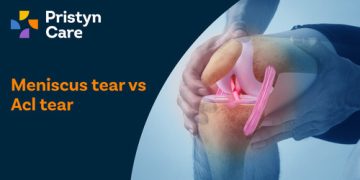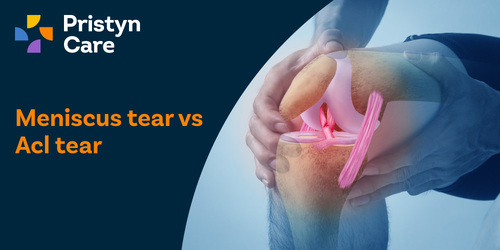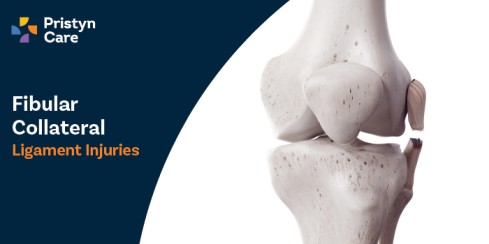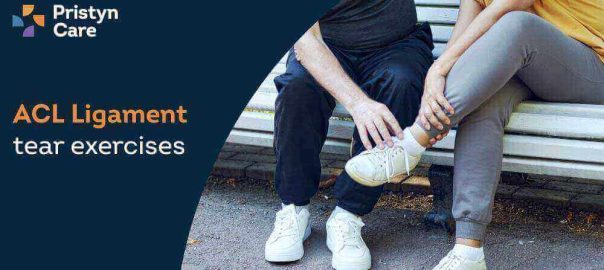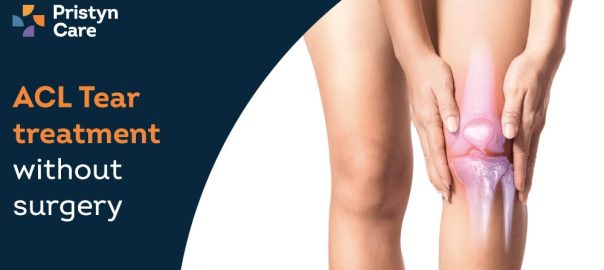![]() Views: 220
Views: 220
Meniscus Tear Vs ACL Tear | Which Is Worse?
Dedicated Support at Every Step!
Our Doctors are available 24 hours a day, 7 days a week to help you!
When you know about the Meniscus tear Vs ACL tear differences, you can identify the right treatment and manage expectations. This comparison not only clarifies the distinct nature of each injury but also guides those affected towards the most effective recovery strategies. Get along with us to see which condition might be worse, factoring in aspects such as pain severity, recovery duration, and long-term impacts on knee health.
Table of Contents
Meniscus Tear Vs ACL Tear Differences | Basic Overview
The knee joint relies on several key structures for stability and smooth movement. Among these, the meniscus, a C-shaped cartilage, cushions and stabilises the joint. It absorbs shock during activities like walking, running, or jumping.
The ACL, or anterior cruciate ligament, is crucial for controlling the knee's back and forth movement. It prevents the tibia from sliding out in front of the femur and provides rotational stability.
How Meniscus Tears Occur: Causes and Mechanisms
Meniscus tears typically arise from movements that put pressure on or rotate the knee joint. Here are the detailed causes and mechanisms:
- Sudden Twists: Occurring frequently in sports, a sharp turn or twist when the foot is planted can tear the meniscus.
- Deep Squatting: Engaging in activities that involve deep knee bends can stress the meniscus, leading to tears.
- Direct Impact: A forceful hit to the knee, such as during a tackle in football, can damage the meniscus.
- Degeneration: Over time, the meniscus weakens and wears thin, making even minor movements potentially injurious.
How ACL Tears Occur: Causes and Mechanisms
ACL injuries are common in activities that involve sudden stops and changes in direction. Here’s what typically leads to these injuries:
- Rapid Deceleration: Sudden slowing or stopping can strain and tear the ACL.
- Incorrect Landings: Jumping and landing incorrectly can overload the ACL, causing it to rupture.
- Pivoting with a Fixed Foot: Turning sharply with a foot planted firmly on the ground can tear the ACL.
- Direct Contact: Collisions in sports like soccer or rugby can result in ACL injuries.
Symptoms Comparison: Meniscus Tear Vs ACL Tear
Comparing the symptoms of meniscus and ACL tears can help differentiate between the two:
- Pain Location: Meniscus tears typically cause pain at the side or centre of the knee, whereas ACL tears often result in more diffuse knee pain.
- Swelling: Both injuries can cause knee swelling, but it’s usually more immediate and severe in ACL tears.
- Knee Function: A locking sensation or difficulty straightening the knee often indicates a meniscus tear. In contrast, an ACL tear might lead to a feeling of instability or the knee buckling under pressure.
- Sound: An audible pop at the time of injury is more common with ACL tears than with meniscus tears.
No Cost EMI, Hassle-free Insurance Approval
Diagnosing Meniscus and ACL Tears
Accurate diagnosis begins with a thorough clinical examination. Here are the techniques commonly used:
- Physical Inspection: Doctors look for swelling, tenderness, and deformity around the knee.
- Range of Motion Tests: These tests assess how far the knee can move in different directions.
- McMurray's Test: This involves bending the knee, then straightening and rotating it to see if there is pain or a clicking sound.
- Lachman Test: Used to check the integrity of the ACL by pulling the tibia forward to see if it moves unusually far.
Imaging Tests: MRI and X-ray Insights
Imaging tests provide a clearer picture of knee health. Key insights include:
- X-ray: This can rule out bone fractures and show the space within the knee joint, which may suggest a meniscus injury.
- MRI: Magnetic Resonance Imaging is crucial for a detailed view. It can show both soft tissues like the ACL and meniscus and any damage to them.
- Comparison to Other Side: Sometimes, images of the uninjured knee are taken to compare the structure and condition.
The Role of Arthroscopy in Diagnosis
Arthroscopy is not just a treatment tool; it's also diagnostic. It involves:
- Minimally Invasive Technique: A small camera is inserted through a cut near the knee, giving doctors a clear view of the inside.
- Direct Observation: Surgeons can see the extent of tissue damage directly.
- Treatment Possibility: If necessary, some issues can be repaired during the diagnostic arthroscopy.
ACL Tear Vs Meniscus Tear Recovery
The initial response to knee injuries can significantly influence recovery outcomes. Here are the essential first steps:
- Rest: Avoid putting weight on the injured knee to prevent further damage.
- Ice: Apply ice packs to reduce swelling and pain. Do this for 20 minutes every two hours for the first 48 hours.
- Compression: Use an elastic bandage around the knee to help control swelling.
- Elevation: Keep the knee raised above the level of the heart to help reduce swelling.
Non-Surgical Treatment Options
Not all knee injuries require surgery. Here are some non-surgical treatments:
- Medication: Pain relievers and anti-inflammatory drugs can help manage symptoms.
- Physical Therapy: Strengthening and flexibility exercises aid in restoring knee function.
- Knee Braces: These can stabilise the knee while it heals.
Surgical Treatments: Techniques and Approaches
- Meniscus Repair: In this procedure, surgeons either suture the torn parts of the meniscus or remove the damaged tissue, depending on the tear's severity and location. The goal is to preserve as much of the meniscus as possible to maintain knee stability and cushioning.
- ACL Reconstruction: This surgery addresses a torn ACL by replacing the ligament with a tissue graft. The graft, often sourced from the patient's own body such as the hamstring or patellar tendon, is used to reconstruct the ligament, restoring the knee's structural integrity and function.
- Orthopaedic Surgery for Knee Injuries: Typically, these procedures utilise arthroscopic techniques. Arthroscopy involves making small incisions through which a camera and surgical instruments are inserted. This method allows the surgeon to view and repair the internal structure of the knee with minimal disruption to surrounding tissues. It results in less postoperative pain, a shorter recovery period, and a quicker return to daily activities.
Rehabilitation and Physical Therapy Strategies
Post-surgery rehabilitation is crucial for full recovery. Effective strategies include:
- Controlled Exercises: Initially, exercises focus on regaining motion and reducing stiffness.
- Strength Building: As healing progresses, exercises aim to strengthen the muscles around the knee.
- Activity Specific Training: Eventually, therapy includes exercises that prepare the individual to return to normal activities or sports.
Each step in the recovery process, from immediate care to rehabilitation, is vital for a successful return to daily activities and sports.
Long-Term Outcomes and Considerations
The long-term outlook varies significantly between meniscus and ACL injuries:
- Meniscus Tears: Recovery can be effective if the tear is small and well-positioned for healing. Some patients may experience persistent pain and mobility issues, particularly if the tear is large or if surgery is required.
- ACL Tears: With surgical repair and proper rehabilitation, many patients return to pre-injury levels of activity. However, the risk of developing osteoarthritis in the injured knee is increased, especially without adequate post-operative care.
Potential Complications and How to Mitigate Them?
Long-term complications can include chronic pain, instability, and decreased range of motion. To mitigate these risks:
- Follow Rehabilitation Protocols: Adhering to a physiotherapist-guided exercise regimen is crucial for recovery.
- Regular Check-ups: Monitoring progress with a healthcare provider can catch complications early.
- Lifestyle Adjustments: Maintaining a healthy weight and avoiding high-impact activities can lessen stress on the knee.
Returning to Sports and Daily Activities
Returning to sports and daily activities requires careful planning:
- Gradual Resumption: Activities should be resumed gradually to avoid overstressing the recovering knee.
- Strength and Flexibility Training: Building muscle strength and enhancing flexibility around the knee are vital to support and stabilise the joint.
- Use of Protective Gear: Wearing a knee brace during activities can provide additional support and prevent re-injury.
Prevention Tips for Knee Injuries
Preventing knee injuries involves a combination of strength training, proper equipment, and lifestyle choices. Here’s how you can protect your knees from damage:
Strengthening and Conditioning Exercises
Strengthening the muscles around your knee is crucial for stability and support:
- Quadriceps and Hamstrings: Exercises like squats and lunges strengthen these key muscles, reducing the burden on your knees.
- Balance Exercises: Incorporate balance-focused activities, such as yoga or using a balance board, to enhance joint stability.
- Regular Stretching: Stretching keeps the muscles flexible, helping prevent injuries during physical activities.
- Core Strengthening: A strong core supports the lower body, including the knees, during movement and activity.
Protective Gear and Sports Techniques
Using the right gear and techniques can significantly reduce knee injury risks:
- Proper Footwear: Shoes that fit well and offer good support can help align your legs correctly, reducing stress on your knees.
- Knee Pads and Braces: These provide extra support and cushion, especially in sports that involve a lot of knee impact and strain.
- Sports Techniques: Learn and practice the correct techniques and movements to avoid putting unnecessary stress on your knees.
Lifestyle Modifications for Joint Health
A healthy lifestyle supports knee health and overall joint function:
- Maintain a Healthy Weight: Extra weight puts additional pressure on your knees. Keeping your weight in check can reduce stress on your joints.
- Nutritious Diet: Foods rich in calcium, vitamin D, and omega-3 fatty acids support bone health and joint lubrication.
- Hydration: Staying hydrated helps maintain the lubrication of your joints, facilitating smoother movement.
- Avoid Smoking: Smoking can impair blood flow, weakening bone structure and exacerbating joint problems.
Final Thoughts on Knee Injury Comparisons
Deciding whether a meniscus tear or an ACL tear is worse depends on several factors including the severity of the injury and individual health conditions. Both injuries can significantly impact your mobility and require appropriate treatment and recovery strategies.
Meniscus tear Vs ACL Tear differences highlight the unique challenges each condition presents. A meniscus tear may heal better if it is minor and located in a well-blooded area of the cartilage, while an ACL tear almost always requires surgical intervention to regain full function of the knee.
Ultimately, understanding these differences can guide individuals in seeking the right treatment and setting realistic recovery expectations. No matter the injury, early diagnosis and proper medical care are crucial for a successful recovery.



